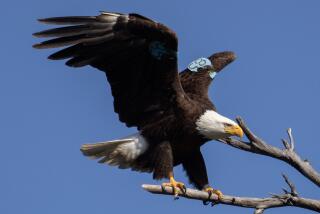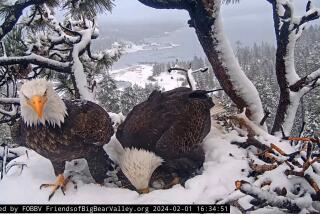A Rare Bald Eagle Hatches
- Share via
After years of trying to bring bald eagles back to the Channel Islands, wildlife officials on Thursday celebrated the first successful, unaided hatching of a chick in more than half a century.
The chick hatched Wednesday on Santa Cruz Island, the largest in the eight-island chain.
“This is a key element in the restoration of the Channel Islands,” said David Garcelon, president of the Institute for Wildlife Studies in Arcata, Calif., which manages the eagle restoration program. “Getting a keystone, top predator back into the system is a tremendous accomplishment” on Santa Cruz Island without the aid of biologists.
A pair of adult eagles, born in captivity but raised on Santa Catalina Island, relocated to Santa Cruz Island last year and established a nest early this year. In March, biologists confirmed the presence of two eggs. They believed one of the eggs was not viable.
Biologists are now waiting for the parents, a 5-year-old male and a 4-year-old female, to feed the unnamed chick. They expect this to happen in the next few days. After about eight weeks, scientists plan to make their first personal contact with the chick, which they will fit with an electronic transmitter and tag for future identification.
The hatching comes during the fifth and final year of the $3.2-million restoration program overseen by the National Park Service, which owns nearly a quarter of Santa Cruz Island, and the Nature Conservancy, which began purchasing the majority parcel of the formerly private island in the late 1970s.
Since the late 1940s, bald eagles have been unable to hatch on the Channel Islands without human help because their eggs contain high levels of toxic PCBs and DDT, a now-banned pesticide that Montrose Chemical Co. and other firms discharged off the Palos Verdes Peninsula in the 1950s and 1960s.
Money for the eagle restoration project came from a $140-million settlement paid by Montrose, other chemical companies and about 100 municipalities.
“We’re doing a lot of restoration programs and now we’re starting to turn the corner,” said Kate Faulkner, chief of natural resources for Channel Islands National Park. “The ban on DDT is what led us to this point today. It’s a long road, but I think this tells us we’re on the right path.”
More to Read
Sign up for Essential California
The most important California stories and recommendations in your inbox every morning.
You may occasionally receive promotional content from the Los Angeles Times.










